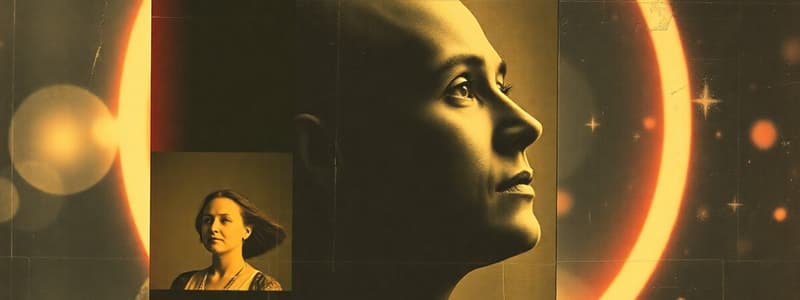Podcast
Questions and Answers
What is the approximate speed of light in a vacuum?
What is the approximate speed of light in a vacuum?
- 150,000 km/s
- 500,000 km/s
- 299,792 km/s (correct)
- 1,000,000 km/s
What is the phenomenon called when light bends as it passes from one medium to another?
What is the phenomenon called when light bends as it passes from one medium to another?
- Refraction (correct)
- Dispersion
- Reflection
- Diffraction
According to the first law of reflection, how are the angles of incidence and reflection related?
According to the first law of reflection, how are the angles of incidence and reflection related?
- The angle of incidence is half the angle of reflection.
- The angle of incidence is twice the angle of reflection.
- The angle of incidence is equal to the angle of reflection. (correct)
- The angle of incidence is the same as the angle of refraction.
Which type of reflection occurs on smooth surfaces like mirrors?
Which type of reflection occurs on smooth surfaces like mirrors?
Which of the following is NOT an application of reflection?
Which of the following is NOT an application of reflection?
Which of the following statements about the dual nature of light is true?
Which of the following statements about the dual nature of light is true?
What occurs during diffuse reflection?
What occurs during diffuse reflection?
Which device uses mirrors to view above the water in submarines?
Which device uses mirrors to view above the water in submarines?
What is the wavelength range of visible light?
What is the wavelength range of visible light?
Study Notes
Properties Of Light
- Speed of Light: Travels at approximately 299,792 km/s in a vacuum.
- Wavelength and Frequency: Light has a range of wavelengths; visible light ranges from about 380 nm (violet) to 750 nm (red).
- Dual Nature: Exhibits both wave-like (interference, diffraction) and particle-like (photons) properties.
- Rectilinear Propagation: Travels in straight lines in uniform media unless acted upon by forces.
- Refraction: Bending of light when passing from one medium to another due to speed change.
Laws Of Reflection
- First Law: The angle of incidence is equal to the angle of reflection (θi = θr).
- Second Law: The incident ray, reflected ray, and normal to the surface all lie in the same plane.
Types Of Reflection
-
Regular Reflection (Specular Reflection):
- Occurs on smooth surfaces (e.g., mirrors).
- Produces clear and defined images.
-
Diffuse Reflection:
- Occurs on rough surfaces (e.g., paper).
- Scatters light in multiple directions, no clear image.
Applications Of Reflection
- Mirrors: Used in personal grooming (bathroom mirrors), optical instruments (telescopes), and imaging.
- Periscopes: Used in submarines to see above the water.
- Optical Devices: Such as cameras and film projectors utilize reflection for capturing images.
- Safety Signage: Reflective materials improve visibility at night.
- Laser Technology: Mirrors are essential for directing laser beams in various applications.
Properties of Light
- Light travels at a very high speed: approximately 299,792 kilometers per second in a vacuum
- Light has a range of wavelengths, with visible light ranging from around 380 nanometers (violet) to 750 nanometers (red)
- Light exhibits both wave-like and particle-like properties, demonstrating phenomena like interference and diffraction (wave-like) and being composed of photons (particle-like)
- Light travels in straight lines in uniform media, unless affected by forces. This is known as rectilinear propagation
- Light bends when it passes from one medium to another, due to a change in its speed. This bending is called refraction
Laws of Reflection
- The angle of incidence (the angle between the incoming light ray and the normal to the surface) is equal to the angle of reflection (the angle between the reflected light ray and the normal to the surface).
- The incident ray, the reflected ray, and the normal to the surface all lie in the same plane.
Types of Reflection
- Regular Reflection (Specular Reflection) Occurs on smooth surfaces such as mirrors and produces clear and defined images
- Diffuse Reflection Occurs on rough surfaces such as paper and scatters light in multiple directions, resulting in no clear image.
Applications of Reflection
- Mirrors have various applications, including personal grooming, optical instruments like telescopes, and imaging.
- Periscopes, used in submarines, rely on reflection to enable viewing above the water.
- Reflection is crucial in optical devices like cameras and film projectors for capturing and projecting images.
- Reflective materials are incorporated in safety signage to improve visibility at night.
- Mirrors are essential for directing laser beams in various applications within laser technology.
Studying That Suits You
Use AI to generate personalized quizzes and flashcards to suit your learning preferences.
Description
Explore the fascinating properties of light and its behavior through various laws of reflection. This quiz covers the speed of light, its wavelength, dual nature, and types of reflection. Test your understanding of these fundamental concepts in physics.




